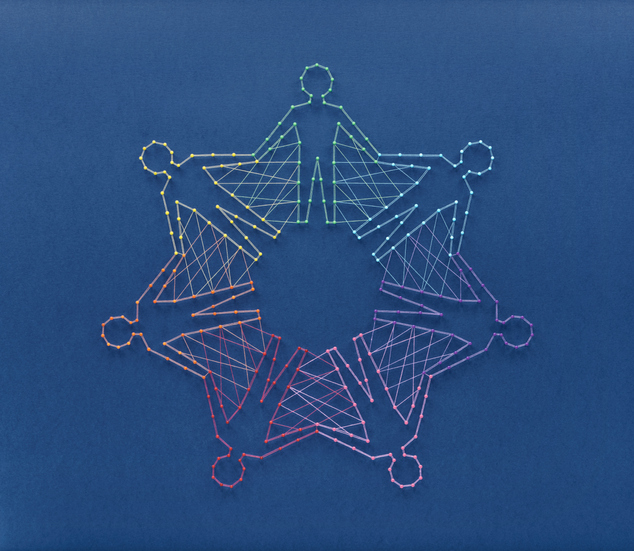As writer Elizabeth Kolbert chronicles in her Pulitzer Prize-winning bestseller, The Sixth Extinction: An Unnatural History, since the dawn of the industrial revolution, humans have added more than 365 billion metric tons of CO2 into the atmosphere through the burning of fossil fuels; have contributed another 180 billion tons through mass deforestation; and throw away an additional 9 billion tons each year—a number that’s increasing by as much as 6 percent annually. The skyrocketing production of plastic and waste generation from inadequate recycling emit an additional 1.8 billion tons—a figure that’s projected to jump another 55 percent by 2050. And “every day, every American in effect pumps seven pounds of carbon into the sea.”
“As a result of all this,” Kolbert concludes, “the concentration of carbon dioxide in the air today—a little over four hundred parts per million—is higher than at any point in the last eight hundred thousand years. Quite possibly it is higher than at any point in the last several million years. [And] if current trends continue, CO2 concentrations will top five hundred parts per million, roughly double the levels they were in preindustrial days, by 2050.”
These statistics are enough to churn anyone’s stomach. Throughout the rest of the book, she examines in minute detail the impact such high concentrations of carbon—and the behaviors that contribute to them—are having on life everywhere, from the seafloor of the Great Barrier Reef to the ice sheets of the Arctic, where ocean acidification and ice ablation caused by global warming are driving species toward extinction at unprecedented rates. By the book’s end, she visits the Frozen Zoo in San Diego, which is currently cryopreserving more than 10,000 living cell cultures, oocytes, sperm, and embryos representing nearly 1,000 species, with the hopes of one day reversing their impending extinction.
“Does it have to end this way?” she asks her readers, desperate for a more positive conclusion to her research. “Does the last best hope for the world’s most magnificent creatures…really lie in pools of liquid nitrogen? Having been alerted to the ways in which we’re imperiling other species, can’t we take action to protect them? Isn’t the whole point of trying to peer into the future so that, seeing dangers ahead, we can change course to avoid them?”
It’s a fair enough question to ask; and one that surely everyone has asked themselves at one point in time, as climate change and its counterpart, “climate anxiety,” continue to wreak growing havoc on the mental health of people across the world—especially in the US. (In fact, according to new data released by Google, global searches related to “climate” or “eco-anxiety” have increased by a staggering 4,590 percent since 2018, a stark reflection of the escalating anguish, despondency, remorse, and despair gripping seemingly everyone these days.)
But as the director of an Alaskan conversation group tells her, the answer ultimately has to be yes. “People have to have hope,” he explains. “I have to have hope. It’s what keeps us going.”
So how can the average American keep the faith?
It might be easier for specialists or experts in the field to have a well-rounded understanding of what is—or isn’t—in our capacity to change for the better; or what, specifically, we can even do, as individuals, to contribute to a sustainable life on earth. But the average person doesn’t have this expert insight. Instead, they’re increasingly turning to counselors, clinicians, and life coaches for the answers, generating massive demand for what is now known as “climate-aware therapy.”
One such climate-aware therapist, Dr. Lise Van Susteren, MD, who co-founded the Climate Psychiatry Alliance to address the growing issue, and authored a web book titled, Climate and the Mind, explains this trend—and her role in it—as such: “In the last couple of years, the focus on the effects of climate on mental and emotional health has skyrocketed […] People generally feel desperation and anxiety about the climate crisis. They hope the therapist will understand and empathize with their deep-seated concerns and help them unpack [them]—or enable them to use their anxiety constructively to address climate [change].”
“[In my therapeutic relationship with my clients], my primary goal is to help a person heal,” she says. “I listen closely to gain understanding, and I validate their emotions and thoughts about climate change. In many cases, that validation is a powerful healing experience unto itself.”
As a psychological phenomenon, climate anxiety appears no different than any other type of anxiety (although there is, of course, one key difference). As such, it can be mitigated with the same types of therapeutic interventions used to treat any other form of anxiety; namely, mindfulness-based approaches (MBIs), acceptance and commitment therapy (ACT), and cognitive-behavioral therapy (CBT), all of which aim to enhance clients’ sense of self-efficacy, resilience, and acceptance of their feelings, while at the same time fostering cognitive detachment from distressing thoughts or emotions. Moreover, the awareness of and alignment with the “here and now”—the present moment—that they promote has been proven to serve as a crucial component in managing climate anxiety, helping to reduce feelings of inertia or despair and redirect one’s attention to the “manifold opportunities” that lay before them to act in line with their values.
“Once I have a sense of the person I am working with,” Susteren explains, “I use that knowledge as a guide in making suggestions about what might be healing. I might ask, ‘Have you given any thought to getting more involved in activities that might reduce carbon emissions?’ ‘Have you given any thought to tracking your carbon footprint so your conscious doesn’t bother you?’ ‘Have you given any thought to standing up to your relatives the next time they deny climate change?’”
It’s this validation and positive-restructuring inherent in the therapeutic process that’s so helpful for addressing climate anxiety as a psychological event and giving clients that essential sense of hope. At the most basic level, people simply want to—or rather, need to—know that they are not alone in their experiences; that they are not less than or weak for having these distressing thoughts or feelings, but also that they are capable of overcoming them.
But when it comes to “not feeling alone” in the context of climate anxiety, specifically, here is where the difference from generalized anxiety emerges: While anxiety, generally, consists of irrational thoughts confined to the person experiencing them, to which therapists can respond from a detached, neutral, even objective perspective, climate change—and its very real consequences—impact (or at least threaten) both therapist and client equally, blurring the lines between them, and thus changing the nature of their relationship entirely.
It for this reason that even the earliest “climate psychologists” delineated climate anxiety as a “social phenomenon” as well as a psychological one. As a 2023 paper published in the Yale Journal of Biology and Medicine puts it, not only do the difficult emotions associated with climate anxiety arise from experiencing ecological loss itself, “but also from the fact that our lives are inescapably embedded in systems that keep on making those losses worse.” Human wellbeing is intrinsically linked to one’s participation in a “healthy eco-cultural context,” psychologist David W. Kidner explains. “Local connection, conviviality, [and] ecological attentiveness […] are inherent human qualities, and their gradual impoverishment […] diminishes all human beings.”
Thus, while therapeutic interventions are still important and effective at helping individuals to cope with or lessen the presence of climate-related anxiety, anger, or despair, there is yet another mediation that parallels them in necessity: and that is social collaboration.
As outlined in a 2022 study examining the role of environmental activism in mitigating climate anxiety—in which one of the contributing causes of individuals’ feelings of helplessness was not so much tied to the enormity or even uncertainty of the situation, but the indifference and ignorance demonstrated by those around them—even just the ability to engage in collective action, and the community connection and support that comes with that, can significantly improve people’s overall health and wellbeing.
In another study examining the impact of pro-environmental behaviors on plastic pollution, researchers found that being a part of a pro-environmental community could inspire hope and a more positive outlook on the future, as information-sharing between members of the group ultimately leads to an increased sense of agency over time. Likewise, research on the mediating role of social support (encompassing both its provision and reception) in mitigating climate-induced stress at work has found that getting involved in relief and recovery efforts after climate change-related events frequently results in post-traumatic growth (often thought to be harder to attain amidst never-ending threats of future disaster), including the ability to find new meaning in life or feel a renewed sense of purpose or appreciation for life.
But what does all that have to do with the workplace, exactly? Everything, in fact.
If climate change is universal enough to blur the boundaries between therapist and client, it should come as no surprise that the same applies to the boundaries between “work” and “life.” As illustrated by the latest Wellbeing Index from Bupa, employees—especially younger ones—are becoming increasingly concerned about their employer’s commitment to sustainability, asserting that they will leave if their employer can’t deliver on their eco-conscious promises.
As equal members of their local communities and human society at large, employees expect that their peers, managers, and—most importantly—their leaders will assume or share in some of the tasks and responsibilities demanded of them outside of work. They expect that their colleagues and supervisors will share in their grief, uncertainty, concern, and their desire for change. They expect that their leaders will care for their employees’—and, in fact, all of their stakeholders’—wellbeing as much as they care about profit or performance, and as such will invest—both emotionally and monetarily—in maintaining their wellbeing, such as by investing in solutions that offer climate-aware counseling or coaching, or by organizing staff-wide training or initiatives that aim to foster that sense of community, togetherness, and drive to act collectively; to act toward positive change.
That is why partnering with third parties like wellbeing solutions providers has become so pronounced as a solution to organizations’ growing mental health crisis: Just as employees’ anxieties recognize that the climate crisis cannot be tackled alone, organizations cannot—and should not—be expected to act alone, either. Whether responding to the climate crisis, the mental health crisis, or both, it takes a concerted, consistent effort at the community level; a kind of “collaborative project” that as Kolbert asserts is “so central to human society,” and might just save it.
By investing in a wellbeing solutions provider for their teams, employers can gain access to that in-the-moment, climate-aware counseling support that’s so essential for making employees’ climate anxiety manageable. Through their 24/7, multimodal access to trained professionals, employees can acquire essential skills for staying present, accepting their lived and internal experiences, and reframing their thinking to find a way forward. They can receive expert guidance on next steps, collaborate on climate-related goals, and access referrals to relevant services, resources, or community groups in their area.
Also through a provider, organizations may benefit from sitewide learning events that promote climate and health awareness, personal resilience, and collective action. By participating in these events, employees can learn how to find and demonstrate solidarity with their peers, how to derive meaning through their work and in their everyday lives, and how to lead lives that align with their core values. For managers and leaders, these events can serve as opportunities for them to enhance their emotional intelligence, guiding them on how they can recognize, reflect on, and effectively respond to signs of climate anxiety in the workplace, and how they can lead with empathy, compassion, and authenticity in an increasingly volatile, uncertain, complex, and ambiguous world.
By implementing a wellbeing ambassador program, employers can further promote a sense of community, togetherness, and camaraderie amongst their teams, building on employees’ abilities to help one another and thus to work toward mutually beneficial goals. And by taking advantage of the team of expert consultants available through their provider, employers can identify and explore further ways in which they can reorient their organization to demonstrate and live out a steadfast commitment to the health of the planet, their communities, and—most importantly—their employees.



































